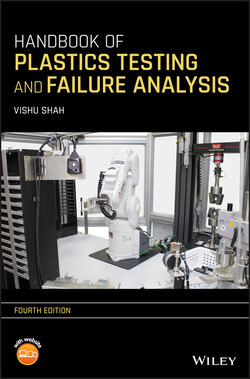Читать книгу Handbook of Plastics Testing and Failure Analysis - Vishu Shah - Страница 16
1.2. SPECIFICATION AND STANDARDS
ОглавлениеA specification is a detailed description of requirements, dimensions, materials, and so on. A standard is something established for use as a rule or a basis of comparison in measuring or judging capacity, quantity, content, extent, value, and quality.
A specification for a plastic material involves defining particular requirements in terms of density, tensile strength, thermal conductivity, and other related properties. The specification also relates standard test methods to be used to determine such properties. Thus, standard methods of test and evaluation commonly provide the bases of measurement required in the specification for needed or desired properties (3).
As discussed earlier, the ultimate purpose of a standard is to develop a common language, so that there can be no confusion or communication problems among developers, designers, fabricators, end‐users, and other concerned parties. The benefits of standards are innumerable. Standardization has provided the industry with such benefits as improved efficiency, mass production, superior quality goods through uniformity, and new challenges. Standardization has opened the door to international trade, technical exchanges, and the establishment of common markets. One can only imagine the confusion the industry would suffer without the specific definition of fundamental units of distance, mass, and time and without the standards of weights and measures fixed by the government (4).
Standards originate from a variety of sources. The majority of standards originate from the industry. The industry standards are generally established by voluntary organizations that make every effort to see that the standards are freely adopted and represent a general agreement. Some of the most common voluntary standards organizations are the ASTM International, the National Sanitation Foundation, the Underwriters Laboratories, the National Electrical Manufacturers Association, and the Society of Automotive Engineers. Quite often, the industry standards do not provide adequate information or are not suitable for certain applications, in which case private companies are forced to develop their standards. These company standards are generally adapted from modified industry standards.
The federal government is yet another major source of standardization activities. The standards and specifications related to plastics are developed by the U.S. Department of Defense and the General Services Administration under the common heading of Military Standards and Federal Standards, respectively.
After World War II, there was a tremendous increase in international trade. The International Standards Organization (ISO) was established for the sole purpose of international standardization. ISO consists of the national standards bodies of over 145 countries from around the world. The standardization work of ISO is conducted by technical committees established by the agreement of five or more countries. ISO’s Technical Committee 61 on plastics is among the most productive of all ISO committees.
